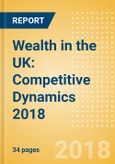Wealth in the UK: Competitive Dynamics 2018
Summary
"Wealth in the UK: Competitive Dynamics 2018" report analyzes the UK wealth management market, with a focus on the top 20 competitors and the HNW investor segment. The report uses findings from 2018 Wealth Managers Survey and 2018 IFA Survey.
The UK’s leading wealth managers outperformed the total UK liquid asset growth in 2017, with acquisitions being a common reason for this growth. Robo-advisors remain the only notable new entrants to the UK wealth management industry; however, the cut-throat robo-advisory market is leading some players to expand into human-led services. With MiFID II and the General Data Protection Regulation (GDPR) entering into force along with substantial compliance costs, regulation remains a top concern among UK financial advisors.
Specifically the report includes -
Scope
Reasons to Buy
Summary
"Wealth in the UK: Competitive Dynamics 2018" report analyzes the UK wealth management market, with a focus on the top 20 competitors and the HNW investor segment. The report uses findings from 2018 Wealth Managers Survey and 2018 IFA Survey.
The UK’s leading wealth managers outperformed the total UK liquid asset growth in 2017, with acquisitions being a common reason for this growth. Robo-advisors remain the only notable new entrants to the UK wealth management industry; however, the cut-throat robo-advisory market is leading some players to expand into human-led services. With MiFID II and the General Data Protection Regulation (GDPR) entering into force along with substantial compliance costs, regulation remains a top concern among UK financial advisors.
Specifically the report includes -
- An overview of the top wealth managers in the UK, based on business model and minimum investment thresholds and ranking based on AUM.
- Recent analysis of regulations that pertain to wealth managers. This includes improved communication with consumers and use of technology.
- Insight into recent M&A activity, new entrants to the UK market, and divestment activity.
- Product and service innovations, including automated services, and personalized offerings.
Scope
- The market leaders in terms of assets under management (AUM) are St. James’s Place, Barclays, and UBS. The AUM of the top 20 UK wealth managers grew by 16% year-on-year between 2016 and 2017.
- UK wealth manager activity is concentrated in London and South East England, with these two regions being home to 29.5% of total UK HNW liquid assets.
- The Financial Conduct Authority (FCA) is working with the wealth industry to support innovation. It has highlighted a lack of transparency among some robo-advisors following the recognition of suitability failings.
- M&A activity continues, with some competitors using it to grow AUM: Canaccord Genuity’s acquisition of Hargreaves Hale boosted the company’s AUM by 83.1%.
- New digital investment platforms continue to enter the UK market, and demand for robo-advisory is leading more established wealth managers to invest and expand into this space.
Reasons to Buy
- Benchmark your market share against the top 20 UK performers.
- Understand drivers for AUM growth among leading wealth managers in the UK.
- Gain insight into M&A activity and organic growth for both new entrants and incumbents.
- Understand changes made to UK regulations related to MiFID, GDPR, and technology.
- Learn about recent product and service innovations among traditional wealth managers.
- Understand the growth within robo-advice services.
Table of Contents
1. EXECUTIVE SUMMARY
2. THE UK WEALTH MANAGEMENT MARKET STRUCTURE
3. REGULATORY TRENDS
4. COMPETITIVE TRENDS
5. APPENDIX
List of Tables
List of Figures
Companies Mentioned (Partial List)
A selection of companies mentioned in this report includes, but is not limited to:
- Addvision Wealth Management
- AFH Financial
- Arbuthnot Latham
- Barclays
- Bedrock Group
- Bessemer Trust
- Brewin Dolphin
- C.Hoard & Co
- Canaccord Genuity Wealth Management
- Canara Bank
- Capital Generation Partners
- Cazenove Capital
- Charles Stanley &Co
- Citi Private bank
- Coutts
- Davy Private Clients
- Equilibrium Asset Management
- Exo Investing
- Fidelity
- Financial Conduct Authority
- Goldman Sachs
- Hargreaves Lansdown
- Harwood Wealth Management
- Hassium Asset Management
- HSBC
- Investec Wealth & Investment
- J.P. Morgan Private Bank
- J.Stern &Co
- Kleinwort Hambros
- Lloyds Banking Group
- Man GLG
- Mattioli Woods
- Moneyfarm
- Nutmeg
- Quilter Cheviot
- Rathbone Brothers
- Sandaire Investment office
- Sanlam UK
- Schroders
- SCM Direct
- Smith & Williamson Investment Management
- Speirs & Jeffrey
- St James’s Place Wealth Management
- Standard life
- Stanhope Capital LLP
- Stonehage Fleming Investment Management
- Tesco Plc
- Thesis Asset Management
- Thomas Moore
- Tiller
- Tilney
- UBS Wealth Management
- Wahed Invest
- Wealthify
- WealthSimple
- Wren Investment Office








